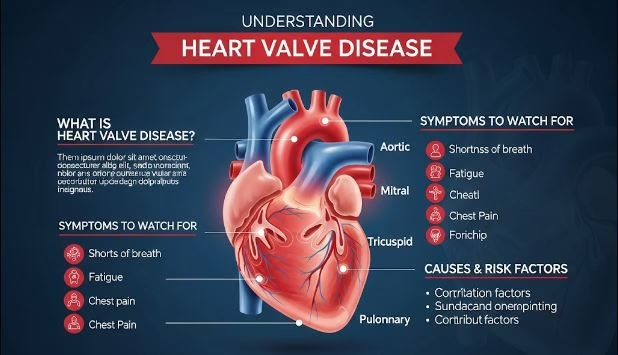Heart Valve Repair Treatment is used to fix damage and anomalies in the heart valve. Primary work of the heart valve is to ensure proper blood flow. There are four valves in the heart and this disease can arise in one or more and either all four valves. There are various common repair techniques as well as critical surgeries. We will look into why it is necessary, what are the benefits and risk factors of this surgery and the complete recovery process.
What is heart valve disease and its symptoms ?
The heart is an intricate and powerful organ which depends on its four valves to ensure the proper blood flows at the proper rate and in the right direction. But, if any of these valves don’t function as they should, heart valve disease occurs, reflecting a significant risk to our overall health. Heart Valve Disease depends on a range of disorders affecting one or more of the heart’s four valves (mitral, aortic, tricuspid, and pulmonary).
Symptoms
Symptoms can vary based on the disease’s severity and affected valve :
- Heart Fluctuations : Sensations of a rapid, fluttering, or pounding heart.
- Feeling of Fatigue : Feeling easily tired during regular activities.
- Swollen Feet or Ankles : Fluid retention can cause these swellings.
- Chest Pain: Discomfort, particularly during increased activity or when lying down.
- Fainting or Dizziness : Due to lack of oxygen-rich blood supply to the brain by heart.
- Shortness of Breath: When lying down or especially during exertion.
What are the major causes of heart valve disease and its risk factors ?
Causes
The causes of heart valve disease can be many, some of as:
- Infections: Such as infective endocarditis, which affects the heart’s inner lining.
- Congenital Heart Defect: Some people are born with abnormalities in their heart valves.
- Age-Related Changes: As one age, the heart valves may become thicker or stiffer.
- Rheumatic Fever: This complication from untreated strep throat can damage heart valves.
- Other Conditions: Such as coronary artery disease, heart attack, or cardiomyopathy.
Risk Factors
There are certain factors which can increase the vulnerability to valve disease:
- Heart Disease: Dealing with any form of heart disease can elevate the risk.
- High Blood Pressure: Chronic hypertension can create extra strain on the heart.
- Age: Older people have a higher risk due to wear and tear on the heart.
- Smoking: USe of tobacco can increase the risk of all heart related diseases, including valve disorders.
- History of Certain Infections: A history of infections that can damage the heart valves.
Heart Valve Disease can have three basic kinds of problems.
Three kinds of heart valve disease are as follows :
Regurgitation
- It happens when the flaps of a valve don’t close tightly
- This allows the blood to leak backwards.
- A common cause of regurgitation is prolapse, where the flaps of the valve flop or bulge back.
- Prolapse most often affects the mitral valve.
- It happens when the flaps of a valve don’t close tightly.
- This allows the blood to leak backwards.
- A common cause of regurgitation is prolapse, where the flaps of the valve flop or bulge back.
- Prolapse most often affects the mitral valve.
Stenosis
- It happens when the flaps of a valve become thick, stiff, or stuck together.
- This prevents the heart valve from opening all the way.
- Not enough blood can pass through the valve.
- Aortic valve stenosis is a common type of stenosis.
- It affects the valve that controls blood flow into the large artery that carries blood out of the heart to the body.
Atresia
- It happens when a heart valve does not form properly.
- Valve does not have an opening for blood to pass through.
Sometimes a valve can have both regurgitation and stenosis.
Factors that can damage valves
- Heart Attack: It can damage the muscles controlling the heart valve or the valve itself.
- Medications: Some drugs, especially certain ones used for treating Migraine, Parkinson’s disease, or even some drugs used for weight loss, have been linked to valve disease.
- Radiation: Risk of heart valve disease can be increased by the Radiation therapy targeted at the chest.
When to Visit Doctor, Diagnostic and Treatment Procedures
When to See a Doctor
Seeking medical attention on time is important. It’s necessary to see a doctor if facing:
- Any of the symptoms mentioned earlier are noticed.
- There’s an irregular heartbeat or heart murmur.
- There’s a family history of heart valve disease.
Diagnostic
When you visit a healthcare provider or hospital for diagnostic, they may recommend:
- Cardiac MRI: Provides detailed images of the heart and its valves.
- Echocardiogram: Uses sound waves to generate detailed images of the heart’s size, structure, and motion.
- Electrocardiogram (ECG): Monitors the heart’s electrical rates.
Treatments
Treatments can range from minimal procedures to critical treatments like open-heart surgery, medications, depending on the disease’s condition and cause.
After Treatments and Surgery
Tell your healthcare provider right away if you have any of these:
- Fever of 100.4°F (38°C) or above, or chills because these may be a sign of infection)
- excessive bruising
- Redness, swelling, bleeding, or drainage from the incision site or any of the catheter sites
- High level of pain around the incision site
- Weakness in the arms and legs
- Uneasiness in breathing
- Lasting nausea or vomiting
- More swelling in the legs or belly
- Fast or irregular pulse
Ask your healthcare provider to give you other instructions after the procedure, depending on your situation.




